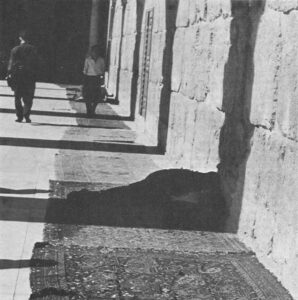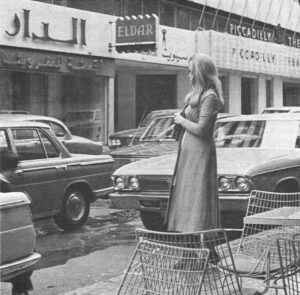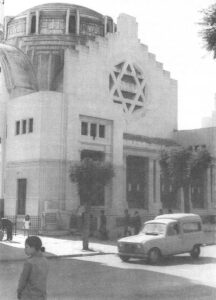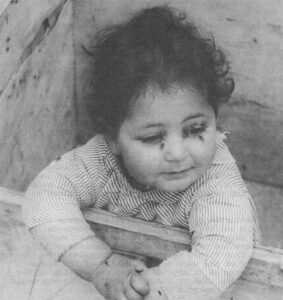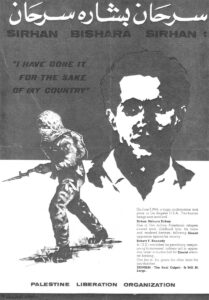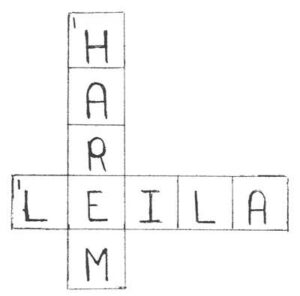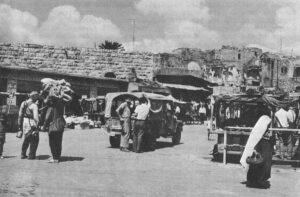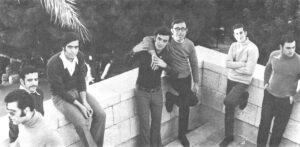I. Who’s Knocking On The Door?
A Goy.
May, 1971
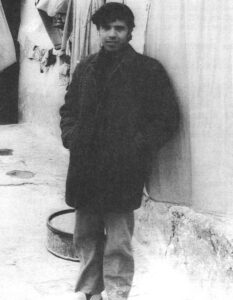
For Hai, whose name in Hebrew means life, life in his Southern Tunisian hometown, Mednine, is hard. He believes that because he is a Jew, he has a hard time keeping steady employment as a carpenter. And since the eighteen year old has befriended the Peace Corps volunteers in the area, the police have questioned him, “What’s a Jew doing mixing with foreigners – Americans?”
Hai compensates for the difficulties he is having with his Muslim townsmen by embellishing tales of the good old days when, Mednine had two thousand inhabitants – all of them Jews. On Saturday [the Jewish Sabbath] everyone would wear their Saturday-best; and in the afternoon, they would promenade to a cafe, have a drink, and not pay until the next day because it’s forbidden to handle money on the Sabbath.”
There is a grain of truth in Hai’s description of Jewish life in Mednine. The seventy Jews who live there now are the remnant of a once thriving community of between six and eight hundred which used to bustle – albeit in squalor – in the Jewish quarter centered around the long, low, blue (for good luck in the Mediterranean world) synagogue and Jewish school.
“In the middle of the twentieth century, an estimated one-half of the Jews of North Africa were descendents of Berber converts,” according to Andre Choraqui, a scholar in the field of North African Jewish history. It should thus come as no surprise that the Jews of Mednine, which is located in Tunisia’s Berber country, seem practically indistinguishable from their non-Jewish neighbors.
Hai’s family, one of the seven Jewish families left in Mednine, lives in a typical, North African manzel (house), that consists of an open courtyard serving as playground, work area, and place to ha I drying clothes surrounded by six or so rooms all activities in which take place on the floor since there is practically no furniture.
Hai lives with an assortment of sisters, brothers, nephews, aunts, parents, and grandparents. His father is a small merchant, a not untypical vocation for Jews who at one time were found in almost every town and village in Tunisia. His step-grandmother is about the same age as his mother. By local standards, the grandmother is a beauty. She is plump, and her traditional Arab maliya (dress) which is folded seven layers thick over the stomach accentuates the weight but hides the shape. Her twenty-two year old daughter – who is thus Hai’s aunt although only four years his elder – is not as blessed with beauty as her mother.
The girl, Shoshana, however, is bright. She attended only briefly the religious school, which provides the only education for the traditional Jew. But Shoshana, whose name in Hebrew means rose, learned Hebrew on her own at home with a tutor, and now she speaks the language adequately although with such a thick Arabic accent that it sounds like a dialect of Arabic. She did not miss much by not continuing her studies at the religious school, which is as medieval as a Muslim kuttub. Instruction consists of rote learning of the Bible, Talmud, and other Holy Scriptures plus a little mathematics and history – all taught in Hebrew. The course hardly prepares the student for life in Mednine, which like the rest of Tunisia is modernizing in such a way that the understanding of French and Arabic or the mastery of some technical skill is becoming essential. The school’s value perhaps is that it offers conversational Israeli Hebrew – in addition to ancient Hebrew – to people like Shoshana who have grown up preparing to immigrate to Israel. The creation of the State of Israel, which is just one year older than Shoshana, has had such an impact on Shoshana’s life that she explains that she is not married at the ripe old age of twenty-two “because I want to wait for my new life in Israel.” (Yet one cannot help worrying about the husband-hunting prospects in modern Israel for this young maiden accustomed to wearing a brown, white, and gold-stripped maliya in the mode of Biblical Israel.)
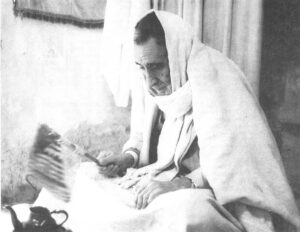
Shoshana’s father – and Hai’s grandfather – is the eldest male in the family and as such the head of the household. Although only sixty-four years old, he looks a patriarch twenty years his elder. He is retired from his business of buying merchandise in Tunis and reselling it to the local population in Mednine. And he, his wife, and Shoshana are waiting until after Passover when the weather becomes unbearably hot in Mednine on the fringes of the Sahara to immigrate to Israel. Meanwhile, he tries to busy his idle, soft, almost feminine hands by swatting flies and making tea in the small, blue enamel tea kettle which is the center of family social life in traditional homes regardless of religion. The grandfather sets the kettle on a kanoon, the Tunisian charcoal-burning pot and fans the coals into a dance in red with a small, wicker fan on a stick. Having boiled the tea several times to just the right strength, he concludes the tea brewing rite by serving the family and guests sitting on the floor in attendance. Then he sinks back motionless, silently sizing up the strangers in his house.
At some undetermined point, the grandfather pulls from somewhere in the folds of his white burnose which seals his body from the winter chill and ultimately conceals him from the eyes of outsiders – a crumbling newspaper article in French.
The article is the key to what sets off his family from the rest of the community of Mednine, which they otherwise resemble in dress, language, food, mores, and even superstitions. For no matter how Arab the family seems and despite their equally ancient, indigenous origins in-the region, they are deeply conscious of being different – being Jewish. And by strictly following the duties of the religion, they constantly remind themselves of this difference. They eat only ritually acceptable food – although it is generally prepared the same way as in a Muslim house. They observe all religious holidays and the Sabbath on Saturday, which further sets them off from the community. Reinforcing their consciousness further are small acts repeated constantly during the day such as kissing the mezuzah (a box containing passages from the Bible hanging on the doorpost of each major room) each time they enter.
The French newspaper article’s shadowy narrative has the power to draw out the silent Jew of Mednine, blanketed in a mental burnose, and send him floating into a Biblical dream world. According to the article, the Ten Lost Tribes of Israel were the founders of the world’s greatest empires and civilizations. Britain, for example, is allegedly a name derived from the Hebrew term, brith, which means covenant, the covenant, made between the Children of Israel and God.
For years, the grandfather has guarded the yellowish scrap of newsprint. He has forgotten – or never knew – where and when it was published. The subject of the article is more real to him than academic details concerning author or origin. After all, it is about Jews like himself, who live attached to the Holy Land, cherish the holy language, Hebrew, and who have maintained and will maintain their ethnic identity long after the newsprint disintegrates. The incredible thesis of the Ten Tribes of Israel is the grandfather’s psychic compensation for a dreary existence in a dying community just as was Hails exaggerated tale of a once glorious, all-Jewish town of Mednine.
In muffled tones, the grandfather recites the legend of his people, which he has practically memorized word for word from the article – even though his French is only good enough to just get by in business. Sharing the story with the strangers in his house is a sign that the grandfather is relaxing and taking the outsiders into his confidence.
Suddenly, there is a loud rapping at the main gate, which leads from the street into the interior courtyard. The family stiffens up. On guard. The grandmother – more straightforward and down to earth than the men in the family – swishes off to answer the abrupt knock. She returns. Whispers are exchanged.
“Who’s at the door?” Hai asks.
“A goy,” replies the grandmother.
The whispering is in Arabic except for the Hebrew word, goy (gentile). Although indistinguishable in outward appearance and behavior from their Muslim neighbors, these Jews live in a mental ghetto. The man at the door is more than just a fellow citizen of Mednine requesting some carpentry work from Hai. He is a goy treading in the ghetto.
This is the mentality of any minority, an objective observer might say. But Hai, his grandfather, his entire family, and the remnant of Jews left in Mednine don’t feel very objective. They feel fear. They have always lived a ghetto life with a minimal of interaction with the community at large. Separatism has traditionally buffered the community from outsiders. But as the Jews over the past twenty-two years depart, the Jewish community, its traditional socioeconomic institutions, and its autonomous existence crumble and leave those families remaining behind exposed. Their sense of vulnerability increases as the number of Jews left behind decreases.
They boast past and future greatness to cover up for present disappointments. Even their descriptions of the present situation in Mednine are not always clear. Hai, for example, had complained once about job discrimination and police harassment, but when the subject was raised a second time, he told a different story.
He said that his only problem was that the Arab men were jealous of him because he knew so many Western women. “Ah,” they say in exasperation – according to Hai, “the Jews are so powerful [popular with the ladies].” They ask Hai why this is so. And Hai says that he can only reply, “Well, just ask them yourself why they don’t want you. I have nothing to do with it.” (Hai does not mention that he may be “powerful with the Western women” not because he is Jewish, but because he went to London several years ago for six months and learned English. This gives him a head start with the women, as do his attractive Mediterranean features spoiled only by bad teeth and the fuzzy beginnings of a moustache.)
If Hai’s comrades’ jealousy is Hails biggest problem, why is he leaving Tunisia? Hai replies, “Each person has a country. The Arabs have Tunisia, Egypt, and everywhere else. The Jews, we have Israel.”
But Tunisia is your home.
“No,” Hai bays, “the Jews have never had a home. My great grandfather was from Spain. We live in Tunisia. But now we all go… And when I go to Israel, I’ll be Israeli and do as Israelis.”
If as an Israeli, you are forced to fight Arabs and even Tunisians, will you?
Hai turns white and pulls in his breath. “No, never. I’ll never fight against Tunisians. But Arabs, I’ll fight if necessary.” For Hai, “Arab” is a political, not ethnic, term referring to those who are the enemy of Israel, his people. “Tunisians,” however, are his neighbors.
Hai, like most Jews of Tunisia, feels no animosity toward the non-Jewish community; and the Muslim Tunisians in general share the same attitude toward the Jews. Instead there exists a laissez-faire separatism between the two groups. Thus, when Hai heard that an American Jew was planning to visit a Muslim family for a week, he was shocked. Hai could not imagine a Jew living in a Muslim household. According to Hai, “They will think the visitor evil. They will know he is American. And if they ask him his religion, it will be disastrous. They will call him a Zionist.”
Hai suggests that the Jew lie about his religion.
Notes
Culturally worlds apart, Hai and Felix, The Zionist of Sidi Bou Said (see the first in this series entitled OBITUARY FOR A PEOPLE: THE JEWS OF TUNISIA), are both members of the remnant of Jews still in Tunisia.
The following are figures on the Jewish communities in 1954 in Tunisian towns in the region of Mednine.
Gafsa – 630
Gabes – 3,400 (five families remain in 1971)
Foum Tatouwine – 500 (six families remain in 1971)
Hai claims Spanish, not Berber descent. If so, it is very unusual to have an ancestor leaving Spain as recently as four generations ago. The major-Spanish Jewish emigration dates from 1492, the Spanish Inquisition, and the expulsion of the Jews and Moors.
Received in New York on June 8, 1971.
©1971 Paula Stern
Paula Stern, a free-lance writer, is an Alicia Patterson Fund award winner. This article may be published with credit to Ms. Stern and the Alicia Patterson Fund.

